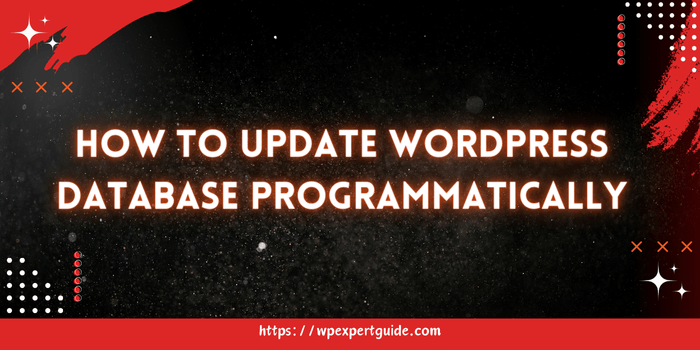How to Update WordPress Database Programmatically

Updating the WordPress database programmatically is a common task for developers who need to automate processes, make bulk changes, or ensure data consistency. This guide will walk you through the process of Updating WordPress Database Programmatically by providing clear explanations, code examples, and tips to ensure your updates are effective and secure.
Introduction
WordPress powers a significant portion of the web, and its database is the backbone that stores all site content, user information, and settings. Knowing how to update the WordPress database programmatically is essential for developers looking to optimize performance, automate updates, or manage data efficiently.
Why Update WordPress Database Programmatically
Updating WordPress Database Programmatically offer several benefits:
- Automation: Automate repetitive tasks to save time.
- Bulk Operations: Make large-scale changes quickly and efficiently.
- Data Integrity: Ensure consistent and accurate data management.
- Customization: Implement custom features that require database modifications.
Understanding WordPress Database Structure
Before making any changes, it’s crucial to understand the structure of the WordPress database. Here are some key tables:
- wp_posts: Contains all posts, pages, and custom post types.
- wp_users: Stores user information.
- wp_options: Stores site-wide settings and options.
- wp_postmeta: Contains metadata for posts.
- wp_usermeta: Contains metadata for users.
Preparation Steps
- Backup Your Database: Always create a backup before making changes to prevent data loss.
- Set Up a Development Environment: Test your updates in a local or staging environment before applying them to the live site.
- Understand Your Requirements: Clearly define what changes need to be made and why.
Connecting to the WordPress Database
To interact with the WordPress database, you need to establish a connection using the wpdb class. This class provides methods to safely execute SQL queries.
Here’s a basic example of how to connect and fetch data:
global $wpdb;
$results = $wpdb->get_results("SELECT * FROM wp_posts WHERE post_status = 'publish'", OBJECT);
foreach ($results as $post) {
echo $post->post_title . '<br>';
}Code Examples
Fetching Multiple Rows of Data
The get_results method retrieves multiple rows from the database. This is useful for fetching lists of posts, users, or other records.
global $wpdb;
$query = "SELECT ID, post_title FROM wp_posts WHERE post_status = 'publish'";
$results = $wpdb->get_results($query, ARRAY_A);
foreach ($results as $row) {
echo 'Post ID: ' . $row['ID'] . ' - Title: ' . $row['post_title'] . '<br>';
}Fetching a Single Row of Data
The get_row method retrieves a single row from the database. This is useful when you need details of a specific record.
global $wpdb;
$query = "SELECT ID, post_title FROM wp_posts WHERE ID = 1";
$row = $wpdb->get_row($query, ARRAY_A);
if ($row) {
echo 'Post ID: ' . $row['ID'] . ' - Title: ' . $row['post_title'];
}Fetching a Single Value
The get_var method retrieves a single value from the database. This is useful for aggregate functions like COUNT or retrieving a single field value.
global $wpdb;
$query = "SELECT COUNT(*) FROM wp_posts WHERE post_status = 'publish'";
$count = $wpdb->get_var($query);
echo 'Number of published posts: ' . $count;Inserting a New Row
The insert method inserts a new row into the database. This is useful for adding new posts, users, or any other records.
global $wpdb;
$wpdb->insert(
'wp_posts',
array(
'post_author' => 1,
'post_title' => 'Programmatically Added Post',
'post_content' => 'This post was added programmatically.',
'post_status' => 'publish',
'post_type' => 'post'
)
);
echo 'New post ID: ' . $wpdb->insert_id;Updating Existing Rows
The update method updates existing rows in the database. This is useful for modifying post titles, user information, or other records.
global $wpdb;
$wpdb->update(
'wp_posts',
array( 'post_title' => 'Updated Title' ),
array( 'ID' => 1 )
);
echo 'Updated post with ID 1';Deleting Rows
The delete method deletes rows from the database. This is useful for removing posts, users, or other records.
global $wpdb;
$wpdb->delete(
'wp_posts',
array( 'ID' => 1 )
);
echo 'Deleted post with ID 1';Best Practices
- Sanitize Inputs: Always sanitize user inputs to prevent SQL injection.
- Use Prepared Statements: Use prepared statements for safer SQL queries.
- Check for Errors: Always check for and handle errors in your SQL queries.
- Optimize Queries: Ensure your queries are efficient to avoid performance issues.
- Follow WordPress Coding Standards: Adhere to WordPress coding standards for readability and maintainability.
Common Use Cases
- Bulk Update Post Metadata: Update custom fields for multiple posts.
- User Role Changes: Programmatically change user roles based on specific criteria.
- Custom Plugin Development: Modify database tables when developing custom plugins.
Example: Bulk Update Post Metadata
Here’s an example of how to update metadata for all posts of a certain type:
global $wpdb;
$post_type = 'product';
$new_meta_value = 'new_value';
$posts = $wpdb->get_results(
$wpdb->prepare("SELECT ID FROM wp_posts WHERE post_type = %s", $post_type)
);
foreach ($posts as $post) {
update_post_meta($post->ID, 'meta_key', $new_meta_value);
}Conclusion
Updating the WordPress database programmatically can be a powerful tool in a developer’s toolkit. By understanding the database structure, using the wpdb class, and following best practices, you can safely and efficiently make the necessary changes to your WordPress site.
Remember, always test your changes in a development environment and keep backups to avoid any potential data loss. With these skills, you’ll be able to handle a wide range of tasks, from bulk updates to custom plugin development, ensuring your WordPress site runs smoothly and efficiently.
By following this comprehensive guide, you should be well-equipped to update the WordPress database programmatically. If you have any questions or need further assistance, feel free to leave a comment below!
